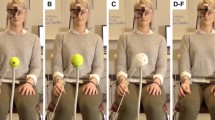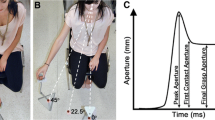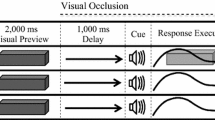Abstract
The Dual Visuomotor Channel theory of reaching proposes that a reach-to-grasp act integrates a Reach, directed toward the extrinsic properties of the target (location), and a Grasp, directed toward the intrinsic properties of the target (size and shape). Previous studies of reach-to-grasp report that the Grasp is altered in pantomime tasks made from a starting position with digit 1 and digit 2 closed and proximal to the target. The present study extends the analysis of real versus pantomime reaching to a task that featured both a Reach and a Grasp, having a starting position with the hand open and proximal to the body. For a real reach, seated participants reached for a doughnut ball (food item) located on a pedestal at arms distance, with the intent of bringing the doughnut ball to the mouth for eating. Participants also made four pantomime reaches with: (1) the doughnut ball removed from the pedestal, (2) the doughnut ball and pedestal moved to the side of the reach location, (3) the doughnut ball and pedestal absent, and (4) the participants wearing vision-occluding glasses. There were two main findings. First, the presence of task-related cues, platform, doughnut ball, and room influenced the kinematics of the Reach and Grasp. Second, the compound structure of a real reach, in which flexion/extension of the arm featured in the Reach and flexion/extension of the digits featured in the Grasp are out of phase, changed in pantomime such that these features of Reach and Grasp became in phase. The results show that pantomime reaching is influenced not only by task-related percepts but also by central mechanisms ordinarily related to integrating the Reach and the Grasp.












Similar content being viewed by others
References
Ansuini C, Giosa L, Turella L, Altoè G, Castiello U (2008) An object for an action, the same object for other actions: effects on hand shaping. Exp Brain Res 185(1):111–119
Arbib MA (1981) Perceptual structures and distributed motor control. Handb Physiol 2:1449–1480. doi:10.1016/j.jphysparis.2008.03.001
Binkofski F, Dohle C, Posse S, Stephan KM, Hefter H, Seitz RJ, Freund HJ (1998) Human anterior intraparietal area subserves prehension A combined lesion and functional MRI activation study. Neurology 50(5):1253–1259
Binkofski F, Buccino G, Posse S, Seitz RJ, Rizzolatti G, Freund H (1999) A fronto-parietal circuit for object manipulation in man: evidence from an fMRI-study. Eur J Neurosci 11(9):3276–3286
Bonivento C, Rothstein P, Humphreys G, Chechlacz M (2014) Neural correlates of transitive and intransitive action imitation: an investigation using voxel-based morphometry. Neuroimage Clin 6:488–497. doi:10.1016/j.nicl.2014.09.010eCollection
Cavina-Pratesi C, Monaco S, Fattori P, Galleti C, McAdam TD, Quinlan DJ et al (2010a) Functional magnetic resonance imaging reveals the neural substrates of arm transport and grip formation in reach-to-grasp actions in humans. J Neurosci 30(31):10306–10323
Cavina-Pratesi C, Ietswaart M, Humphreys GW, Lestou V, Milner AD (2010b) Impaired grasping in a patient with optic ataxia: primary visuomotor deficit or secondary consequence of misreaching? Neuropsychologia 48(1):226–234
Culham JC, Valyear KF (2006) Human parietal cortex in action. Curr Opin Neurobiol 16(2):205–212
De Sanctis T, Tarantino V, Straulino E, Begliomini C, Castiello U (2013) Co-registering kinematics and evoked related potentials during visually guided reach-to-grasp movements. PLoS One 8(6):e65508
Eshkol N, Wachman A (1958) Movement notation. Weidenfeld and Nicolson, London
Fattori P, Kutz DF, Breveglieri R, Marzocchi N, Galletti C (2005) Spatial tuning of reaching activity in the medial parieto-occipital cortex (area V6A) of macaque monkey. Eur J Neurosci 22(4):956–972
Filimon F (2010) Human cortical control of hand movements: parietofrontal networks for reaching, grasping, and pointing. Neuroscientist 16(4):388–407
Fukui T, Inui T (2013) How vision affects kinematic properties of pantomimed prehension movements. Front Psychol 4:44. doi:10.3389/fpsyg.2013.00044
Gharbawie OA, Stepniewska I, Kaas JH (2011) Cortical connections of functional zones in posterior parietal cortex and frontal cortex motor regions in new world monkeys. Cereb Cortex 21:1981–2002. doi:10.1093/cercor/bhq260
Goodale MA, Jakobson LS, Keillor JM (1994) Differences in the visual control of pantomimed and natural grasping movements. Neuropsychologia 32(10):1159–1178
Hall LA, Karl JM, Thomas BL, Whishaw IQ (2014) Reach and Grasp reconfigurations reveal that proprioception assists reaching and hapsis assists grasping in peripheral vision. Exp Brain Res 232:2807–2819. doi:10.1007/s00221-014-3945-6
Holmes SA, Lohmus J, McKinnon S, Mulla A, Heath M (2013) Distinct visual cues mediate aperture shaping for grasping and pantomime-grasping tasks. J Mot Behav 45:431–439. doi:10.1080/00222895.2013.818930
Jazi SD et al (2015) Pantomime-grasping: the ‘return’of haptic feedback supports the absolute specification of object size. Exp Brain Res 233(7):2029–2040
Jeannerod M (1981) Intersegmental coordination during reaching at natural visual objects. Atten Perform IX 9:153–168
Jeannerod M (1999) Visuomotor channels: their integration in goal-directed prehension. Hum Mov Sci 18(2):201–218
Jeannerod M, Decety J, Michel F (1994) Impairment of grasping movements following a bilateral posterior parietal lesion. Neuropsychologia 32(4):369–380
Kaas JH, Gharbawie OA, Stepniewska I (2011) The organization and evolution of dorsal stream multisensory motor pathways in primates. Front Neuroanat 5:1–7. doi:10.3389/fnana.2011.00034.eCollection
Karl JM, Whishaw IQ (2014) Haptic grasping configurations in early infancy reveal different developmental profiles for visual guidance of the Reach versus the Grasp. Exp Brain Res 232(10):3301–3316. doi:10.1007/s00221-014-4013-y
Karl JM, Sacrey LA, Doan JB, Whishaw IQ (2012) Hand shaping based on hapsis resembles visually guided hand shaping. Exp Brain Res 219:59–74. doi:10.1007/s00221-012-3067-y
Karl JM, Schneider LR, Whishaw IQ (2013) Non-visual learning of intrinsic object properties in a reaching task dissociates grasp from reach. Exp Brain Res 225(4):465–477. doi:10.1007/s00221-012-3386-z
Króliczak G, Cavina-Pratesi C, Goodman DA, Culham JC (2007) What does the brain do when you fake it? an fMRI study of pantomimed and real grasping. J Neurophysiol 97:2410–2422
Oldfield RC (1971) The assessment and analysis of handedness: the Edinburgh inventory. Neuropsychologia 9(1):97–113
Pettypiece CE, Goodale MA, Culham JC (2010) Integration of haptic and visual size cues in perception and action revealed through cross-modal conflict. Exp Brain Res 201:863–873. doi:10.1007/s00221-009-2101-1
Rizzolatti G, Matelli M (2003) Two different streams form the dorsal visual system: anatomy and function. Exp Brain Res 153:146–157
Rizzolatti G, Luppino G, Matelli M (1998) The organization of the cortical motor system: new concepts. Electroencephalogr Clin Neurophysiol 106:283–296
Sacrey LAR, Whishaw IQ (2012) Subsystems of sensory attention for skilled reaching: vision for transport and pre-shaping and somatosensation for grasping, withdrawal and release. Behav Brain Res 231(2):356–365
Sacrey LA, Alaverdashvili M, Whishaw IQ (2009) Similar hand shaping in reaching-for-food (skilled reaching) in rats and humans provides evidence of homology in release, collection, and manipulation movements. Behav Brain Res 204:153–161. doi:10.1016/j.bbr.2009.05.035
Saling M, Mescheriakov S, Molokanova E, Stelmach GE, Berger M (1996) Grip reorganization during wrist transport: the influence of an altered aperture. Exp Brain Res 108(3):493–500
Sartori L, Staulino E, Castiello U (2011) How objects are grasped: the interplay between affordances and end-goals. PLoS One 6(9):e25203. doi:10.1371/journal.pone.0025203
Shallice T, Venable N, Rumiati RI (2005) Dissociable distal and proximal motor components: evidence from perseverative errors in three apraxic patients. Cogn Neuropsychol 22(5):625–639. doi:10.1080/02643290442000248
Smeets JB, Brenner E (1999) A new view on grasping. Mot Control 3(3):237–271
Tagliabue M, Ciancio AL, Brochier T, Eskiizmirliler S, Maier MA (2015) Differences between kinematic synergies and muscle synergies during two-digit grasping. Front Hum Neurosci 9:165. doi:10.3389/fnhum.2015.00165.eCollection
Tanne-Gariepy J, Rouiller EM, Boussaoud D (2002) Parietal inputs to dorsal versus ventral premotor areas in the macaque monkey: evidence for largely segregated visuomotor pathways. Exp Brain Res 145:91–103. doi:10.1007/s00221-002-1078-9
Taylor LJ, Zwaan RA (2010) Grasping spheres, not planets. Cognition 115(1):39–45. doi:10.1016/j.cognition.2009.11.006
Thomas BL, Karl JM, Whishaw IQ (2014) Independent development of the Reach and the Grasp in spontaneous self-touching by human infants in the first 6 months. Front Psychol 5:1526. doi:10.3389/fpsyg.2014.01526eCollection
Valyear KF, Chapman CS, Gallivan JP, Mark RS, Culham JC (2011) To use or to move: goal-set modulates priming when grasping real tools. Exp Brain Res 212(1):125–142. doi:10.1007/s00221-011-2705-0
Vesia M, Bolton DA, Mochizuki G, Staines WR (2013) (2013) Human parietal and primary motor cortical interactions are selectively modulated during the transport and grip formation of goal-directed hand actions. Neuropsychologia 51:410–417. doi:10.1016/j.neuropsychologia.2012.11.022
Vry MS et al (2015) The ventral fiber pathway for pantomime of object use. Neuroimage 106:252–263
Westwood DA, Chapman CD, Roy EA (2000) Pantomimed actions may be controlled by the ventral visual stream. Exp Brain Res 130(4):545–548
Whishaw IQ, Karl JM (2014) The contribution of the Reach and the Grasp to shaping brain and behaviour. Can J Exp Psychol 68(4):223–235
Whishaw IQ, Suchowersky O, Davis L, Sarna J, Metz GA, Pellis SM (2002) Impairment of pronation, supination, and body co-ordination in reach-to-grasp tasks in human Parkinson’s disease (PD) reveals homology to deficits in animal models. Behav Brain Res 133(2):165–176
Whishaw IQ, Travis SG, Koppe SW, Sacrey LA, Gholamrezaei G, Gorny B (2010) Hand shaping in the rat: conserved release and collection vs. flexible manipulation in overground walking, ladder rung walking, cylinder exploration, and skilled reaching. Behav Brain Res 206:21–31
Whitwell RL, Milner AD, Goodale MA (2015) The two visual systems hypothesis: new challenges and insights from visual form agnosic patient DF. Arm Hand Mov Curr Knowl Futur Perspect 5(255):98
Author information
Authors and Affiliations
Corresponding author
Electronic supplementary material
Below is the link to the electronic supplementary material.
Supplementary material 1 (MOV 19013 kb)
Supplementary material 2 (MOV 13612 kb)
Supplementary material 3 (MOV 17402 kb)
Supplementary material 4 (MOV 14419 kb)
Supplementary material 5 (MOV 15402 kb)
Rights and permissions
About this article
Cite this article
Kuntz, J.R., Whishaw, I.Q. Synchrony of the Reach and the Grasp in pantomime reach-to-grasp. Exp Brain Res 234, 3291–3303 (2016). https://doi.org/10.1007/s00221-016-4727-0
Received:
Accepted:
Published:
Issue Date:
DOI: https://doi.org/10.1007/s00221-016-4727-0




